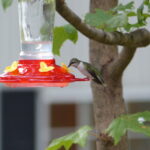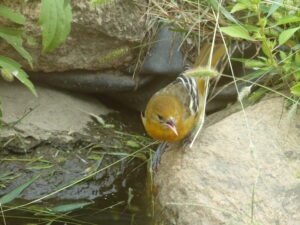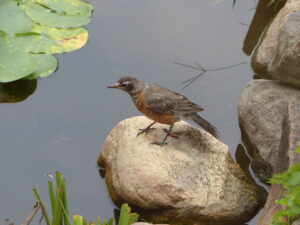A flurry of movement caught our attention. Just outside the dining room window, a tiny scrap of a bird flitted around. It wasn’t a wren, goldfinch, or sparrow. They’re around all year. Just what was it?
For most birders, May is the month to live for. Orioles, grosbeaks, tanagers, and warblers arrive as if by magic. They’re colorful, sing with gusto, and are easy to spot. It’s an exciting time, but it’s not THE ONLY exciting time.
All the colorful migrating May birds en route to northern nesting sites and the ones that stick around to nest locally are now heading south to avoid winter’s harshness. September is an outstanding birding month, but it’s also challenging.
September Birding

Birds stock up on high-calorie foods before their long migrations.
The birds are there but easy to miss. Many have gone through a late summer molt. They’ve replaced gaudy spring feathers with drab ones that enable them to hide better. September is a business month for birds. In May they happily court mates, but four months later the priority is beefing up their bodies for the long flight south. They dart about, often out of sight, seeking tasty insects, spiders, and seeds to fuel migration.
September birding takes patience. We find the most effective way to see birds is to sit quietly and watch. While we may slowly walk trails spotting birds in May, by September we sit on our deck in comfortable chairs, binoculars handy, and bird books and apps at the ready. We don’t find the birds. They find us, but because they don’t sing much and often look different than in Spring, identification is challenging.
Our backyard birding is exciting because we’ve diversified vegetation and have brushy areas, a prairie, a small pond, and big trees close by. However, we don’t just look there for birds. Sometimes we look upward to see soaring nighthawks, migrating raptors, and an occasional skein of Canada geese.
- Birds stop for a drink and to fill up on the berries nearby.
- Keeping a wary eye, the robin cautiously gets a drink.
Identifying Fall Birds
To help with identification we use several printed bird books including the Peterson Guide and David Allen Sibley’s books. Increasingly we rely on Merlin. It’s an outstanding app produced by the Cornell University Laboratory of Ornithology. Even better, it’s free. The app easily helps identify species and shows many photos of every bird in spring/fall/juvenile/gender plumages. It also has range maps and recordings of the birds’ calls and songs. Merlin recently added a new function: sound identification. Point the phone at a singing bird and the app will help identify it by sound.
After we tentatively identify a bird, we try to confirm it by an Internet search and by consulting our birding friends. Our definitive online source is the Lab of Ornithology’s website. The site contains a vast amount of information, including how to access and use Merlin and eBird.
Easy to Keep Records
eBird allows us to record all bird species we spot in a day. Then we email results to the Lab for analysis. It’s great fun and helps the Lab research bird populations and movement.
There’s more to fall than football and leaf raking. It’s an excellent time to bird and the best birding is often the backyard.




Thanks for a great article on autumn bird migration. I still have some bluebirds, sparrows, hummingbirds around. There have been some warblers here feasting on the insects in our bushes. I think they might have been Tennessee warblers. I’m keeping an eye out for the raptors. They are making their way along the Blue Ridge Mountains west of us. We saw several on Wheats Valley road Friday.